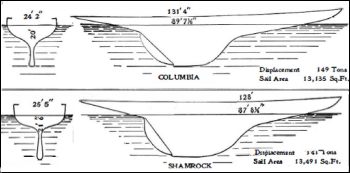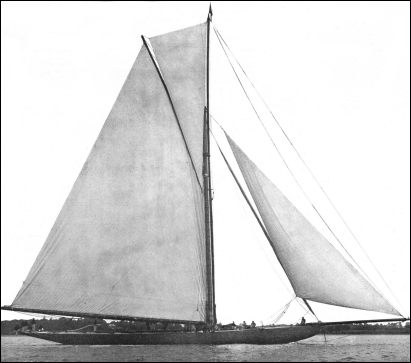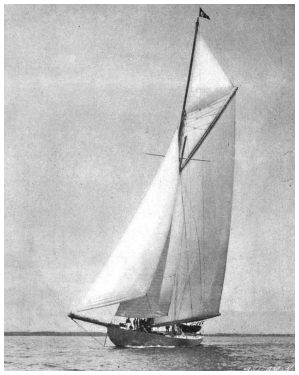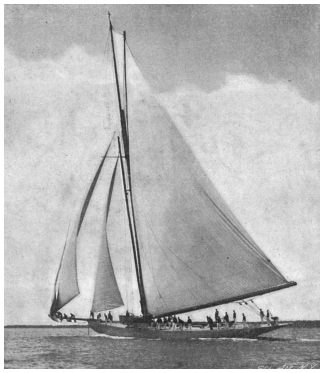Yves GARY Hits: 500
Category: 1899 : CHALLENGE N°10
 © 1899 SCIENTIFIC AMERICAN, INC : AUGUST 12, 1899
© 1899 SCIENTIFIC AMERICAN, INC : AUGUST 12, 1899Now that Shamrock, the sixth British cutter to cross the Atlantic in quest of the America cup since 1885, is well on her way over the Western Ocean , it will be of interest to compare her sailing qualities with those of the boat which is certain to be chosen for the defense.
Genesta, Galatea, Thistle, Valkyrie II. and Valkyrie III - it is a right royal line with which this Anglo-Scotch-Irish craft is associated in holding her title of challenger ; and with her Irish name, Scotch design, and English construction, she is truly representative of the people to whose fostering care the early growth of the sport of yacht sailing and its present popularity are largely due.
We have already pointed out, in former notices of Columbia and Shamrock, that in the dimensions and construction of their hulls there is great similarity between the two boats. Columbia, though stronger than Defender, is yet a remarkably light craft, and in Shamrock Thornycroft, with his quarter of a century's experience in torpedo-boat building, has produced a hull and spars that are probably an advance over the American boat in the matter of light scantling and up-to-the-limit construction. The continued secrecy as to Shamrock's under-water body is no doubt due to a wish to conceal her excessive draught, and it is not unlikely that she will be found to draw as much as 22 feet. This would mean lower lead, less of it, and a nearer approach to the true fin keel than has been shown in any 90-foot yacht since the construction of our own Pilgrim in 1893.
As will be readily seen by a study of the beam views of the two vessels there are notable differences in their sail plans. Shamrock's mast appears to be stepped about 2 feet further aft than Columbia's, and her bowsprit is considerably longer, the distance from mast to outer end of bowsprit being from 5 to 7 feet greater in Shamrock. Her present boom is about the same length as Columbia's. The gaff, topmast, and hoist of mainsail, on the other hand, are a few feet less than Columbia's, so that the sail plan is longer on the base line but not so lofty as that of the American boat.
 She probably carries a larger spinnaker, larger head sails, and a smaller mainsail, the effect of which, other things being equal, should be to give Columbia the advantage in windward work and Shamrock in reaching and running. Her owner, Sir Thomas Lipton, and her designer, Fife, have both stated that she is to carry a larger mainsail in the races on this side.
She probably carries a larger spinnaker, larger head sails, and a smaller mainsail, the effect of which, other things being equal, should be to give Columbia the advantage in windward work and Shamrock in reaching and running. Her owner, Sir Thomas Lipton, and her designer, Fife, have both stated that she is to carry a larger mainsail in the races on this side.
A fairly reliable comparison of the sailing qualities of the two boats is obtained by studying the remarkable series of races sailed by Britannia and Vigilant in 1894, and comparing the results with the performance in America of Vigilant against Defender, in 1895, and Defender against Columbia, in 1899, and with the recent trials in England of Britannia against Shamrock. Of course the value of such comparisons depends upon the boats Vigilant and Britannia being as fast in subsequent years as they were in 1894. There is no doubt that they were in as good condition, and possibly better. Vigilant was improved in 1895 by the removal of 43,000 pounds of lead from the inside and the addition of 53,000 pounds to the outside of the keel, and Britannia, in addition to the improvements in trim, sai l-plan, etc, due to three years of continuous racing , was recoppered, her topsides replaned and carefully smoothed off, and her wooden boom was replaced by one of steel, before she raced Shamrock The Vigilant » and « Britannia sailed seventeen races, of which Britannia won eleven and Vigilant six. This would appear to denote a decided superiority in Britannia, and in winds of a certain strength she was superior. In races sailed at an average speed of 8 knots an hour or less, Britannia usually won, and her wins were larger the lighter the wind; but when the average speed exceeded 8 knots an hour, it was Vigilant's day, and the harder it blew, the greater was her margin of winning. Dixon Kemp, the well-known English yachting expert, summing up the season's work, pronounced the boats about equal. That the verdict is a just one is shown by the following results. On a 50-mile course sailed at an average speed of 8.3 knots in a fine whole-sail breeze, Britannia won by 35 seconds: but over the same course with lighter wind, sailing at an average speed of 6.3 knots, she won by 5 minutes 52 seconds.
In another 50-mile race sailed at 6,4 knots speed, however, Vigilant won by 3 minutes 52 seconds, In a strong breeze, the Vigilant sailing at a speed of 9.6 knots, beat Britannia by 4 minutes 32 seconds over a 50-mile course, which would be equivalent to 2 minutes 43 seconds on a 30-mile course.
Then, Britannia wins a 50-mile race by 22 seconds, sailing at an average speed of 8.7 knots. Vigilant's best win was at the rate of 4 minutes over a 30-mile course, the average speed being 11.2 knots in a strong wind. Other wins of Britannia were by 1 minute 27 seconds, 2 minutes 14 seconds, and 2 minutes 4 seconds over 50-mile courses. The results bear out the statement of Dixon Kemp that in the give and take of yachting weather the boats are very evenly matched.
In comparing Shamrock and Columbia through these two boats, we shall take the actual times made over specified distances on the different points of sailing, namely, beating, reaching, and running; and we shall consider only official races, in which the distances and times were accurately known and taken by a sailing committee. Records of informal brushes are quite unreliable both as to distance and time.
 In Shamrock's first race, according to the English Yachtsman, Britannia started well ahead of Shamrock, but was worsted by 6 minutes 13 seconds in a beat of 8 knots dead to windward, the distance being covered in about one hour, Shamrock owing to an accident to her club-topsail, carried only the jib-headed topsail, shown in our photographs, which were taken during the progress of this race. The Britannia carried her large club topsail, and we may reasonably suppose that with her own club-topsail set, Shamrock would have gained fully 6 minutes 30 seconds in the 8 miles.
In a race 15 miles to windward and return over the Sandy Hook course this would mean a gain of 12 minutes 10 seconds over Britannia in the beat to windward. Now, in beating twice over a stretch of 7 miles to windward during a race sailed on the Clyde at an average speed of about 8.3 knots, Vigilant gained 2 seconds on the first round and Britannia 7 seconds on the second round; and in other work to windward in races sailed at the same speed as the first Shamrock-Britannia race, Vigilant and Britannia were approximately equal. This would show Shamrock to be about 12 minutes 10 seconds faster in 15 miles windward work than Vigilant. In the Defender-Vigilant trial races off Sandy Hook Defender gained on Vigilant 6 minutes 33 seconds on a 10-mile beat to windward. This would amount to 9 minutes 50 seconds in 15 miles, the speed of the Defender being 7.3 knots per hour measured dead to windward, while the speed of the Shamrock to windward in her race with Britannia was 7.8 knots. In the recent Sandy Hook trial race Columbia beat Defender 2 minutes 25 seconds in 10 miles to windward at a speed of 6.1 knots. This would amount to 3 minutes 37 seconds gain in 15 miles, or if sailed at the speed of the Shamrock-Britannia race the gain would be, say, about 3 minutes 30 seconds in 15 miles to windward.
This makes Columbia 13 minutes 20 seconds faster than Vigilant or Britannia in 15 miles to windward at a 7.8-knot speed, and 1 minute 10 seconds faster than Shamrock over the same course under the same conditions.
In Shamrock's first race, according to the English Yachtsman, Britannia started well ahead of Shamrock, but was worsted by 6 minutes 13 seconds in a beat of 8 knots dead to windward, the distance being covered in about one hour, Shamrock owing to an accident to her club-topsail, carried only the jib-headed topsail, shown in our photographs, which were taken during the progress of this race. The Britannia carried her large club topsail, and we may reasonably suppose that with her own club-topsail set, Shamrock would have gained fully 6 minutes 30 seconds in the 8 miles.
In a race 15 miles to windward and return over the Sandy Hook course this would mean a gain of 12 minutes 10 seconds over Britannia in the beat to windward. Now, in beating twice over a stretch of 7 miles to windward during a race sailed on the Clyde at an average speed of about 8.3 knots, Vigilant gained 2 seconds on the first round and Britannia 7 seconds on the second round; and in other work to windward in races sailed at the same speed as the first Shamrock-Britannia race, Vigilant and Britannia were approximately equal. This would show Shamrock to be about 12 minutes 10 seconds faster in 15 miles windward work than Vigilant. In the Defender-Vigilant trial races off Sandy Hook Defender gained on Vigilant 6 minutes 33 seconds on a 10-mile beat to windward. This would amount to 9 minutes 50 seconds in 15 miles, the speed of the Defender being 7.3 knots per hour measured dead to windward, while the speed of the Shamrock to windward in her race with Britannia was 7.8 knots. In the recent Sandy Hook trial race Columbia beat Defender 2 minutes 25 seconds in 10 miles to windward at a speed of 6.1 knots. This would amount to 3 minutes 37 seconds gain in 15 miles, or if sailed at the speed of the Shamrock-Britannia race the gain would be, say, about 3 minutes 30 seconds in 15 miles to windward.
This makes Columbia 13 minutes 20 seconds faster than Vigilant or Britannia in 15 miles to windward at a 7.8-knot speed, and 1 minute 10 seconds faster than Shamrock over the same course under the same conditions.
Now, with the Columbia over 1 minute ahead at the weather mark, what would be Shamrock's chances of winning out in the 15-mile run to the finish ? In the Vigilant-Britannia races Britannia showed a slight superiority in running. In the Clyde race, at an average speed of 8.6 knots, she gained 45 seconds on an 11-mile run ; again, in a fresh club-topsail breeze, she gained 2 minutes on a 4-mile run, though on a second run of 4 miles the boats were even. In a strong westerly wind, although Vigilant won by 5 minutes over the whole course, the boats took the same time to run 5 miles ; and in a race at 8 knots average speed Britannia gained 45 seconds on a 3½-mile run. We may fairly consider Britannia to be at least equal to Vigilant when running before the wind.
Now in the Sandy Hook trials Vigilant took 1 minute 33 seconds less than Defender to run 10 miles, a gain of 220 seconds in 15 miles. This was in a race whose average speed was 9 knots; but in an earlier race Defender beat Vigilant by 41 seconds in a run of the same distance. A consideration of all their races would show Vigilant to be faster on the average than Defender in a 15-mile run by about 1 minute and 30 seconds.
Columbia and Defender'' have had but few trials with their spinnakers spread. At Larchmont, in two runs over a 3-mile leg, there was in each run only from two to five seconds difference between the yachts, and the various trials show that Columbia is on the average about 30 seconds faster than Defender in 15 miles on this point of sailing, This would indicate that Britannia and Vigilant are about 1 minute faster than Columbia in a 15-mile run to leeward with spinnakers set.
Shamrock gained only 2 minutes 30 seconds on a 15-mile run with Britannia, the speed being about the same as that in the various races above mentioned.
Had she carried her club topsail and not split her spinnaker, she would have beaten Britannia by about 2 minutes 45 seconds. This suggests that Shamrock is about 3 minutes 45 seconds faster than Columbia on a 15-mile run ; but the fact that in any race the last boat in a run before the wind has the advantage of a clear wind makes all such estimates of comparative running ability less reliable than estimates of work to windward. However, on the results as found, we see that judged by their actual performances in winds of similar strength, Shamrock should win a 30-mile race to windward and return by about 2½ minutes.
 Columbia should win easily on a triangular course, which is made up of 30 miles of reaching or 20 miles of reaching and 10 miles of windward work.
Columbia should win easily on a triangular course, which is made up of 30 miles of reaching or 20 miles of reaching and 10 miles of windward work.
Vigilant was superior to Britannia in reaching if the breeze was at all fresh . She gained on one occasion 2 minutes in a 10-mile reach, or say 4 minutes on 20 miles. In a broad reach of 61 miles, sailed at the high speed of over 13 knots, Defender gained 3 minutes 30 seconds on Vigilant or 1 minute 10 seconds on 20 miles. At the 9.2-knot speed of the Shamrock-Britannia race this would have amounted to about 1 minute 30 seconds on 20 miles, which added to Vigilant's gain of 4 minutes over Britannia shows Defender to have an advantage of 5 minutes and 30 seconds on 20 miles of reaching.
Columbia has not shown, so far, much superiority to Defender in reaching. She gained 1 minute 33 seconds on a 10-mile reach at Sandy Hook at a 10.2-knot speed; but Defender at Larchmont was faster by 1 minute 7 seconds and again by 1 minute 40 seconds on a 10-mile reac h, Defender, however, was better handled, and perhaps it would be safe to say Columbia is 30 seconds faster in 20 miles of reaching in her present condition. This would show the cup defender to be 6 minutes faster than Britannia in the two 10-mile legs of reaching on a 30-mile course.
Now Shamrock appears to have proved a disappointment in reaching during her first race, gaining on Britannia only at a rate equivalent to 1 minute in 20 miles of broad reaching. If the triangular course contains 20 miles of reaching and 10 miles of windward work, we see that Columbia would gain 6-1 =5 minutes in reaching and about 45 seconds to windward, winning the race by something under 6 minutes.
Summing up then, we find that a comparison of the yachts on their actual timed performances in official races, where the speed is over 8 knots an hour, Shamrock shows a slight advantage over a windward and leeward course, and Columbia a decided superiority over a triangular course. So much for work in a fine club-topsail breeze. Unfortunately the work of Shamrock in a light wind during a second race was not carefully timed. She appears to have gained about a quarter of an hour over half of a 36-mile course, and Lipton and his captains estimate that she would have gained 30 minutes if Britannia had finished the race. We have seen that Britannia did her best work against Vigilant in light airs, especially to windward , and it was in this very work that Shamrock appears to have walked away from the Prince of Wales' cutter. In the absence of reliable figures, we have attempted no estimate of the relative speed of Columbia and Shamrock in light winds; but the indications are that the security of the America cup will be enhanced by the prevalence of strong and steady breezes during the first week of October.
In conclusion it may be said that the above estimates may be entirely upset by the changes in sail-pIan, trim, etc in either or both yachts before the trials take place. When they cross the line on October 3 Columbia will have had three months to tune up to racing condition, and the improvements in speed which result from lengthy trials against Defender should easily reverse the slight advantage which Shamrock at present seems to possess on a windward and leeward course. The races will not be much closer this year than before; and the home boat will probably win out by the usual comfortable margin - a conviction which to our mind is strengthened by the fact that since the above was written Watson's Meteor, an improved Valkyrie III, has beaten Britannia by greater margins than Shamrock accomplished.
